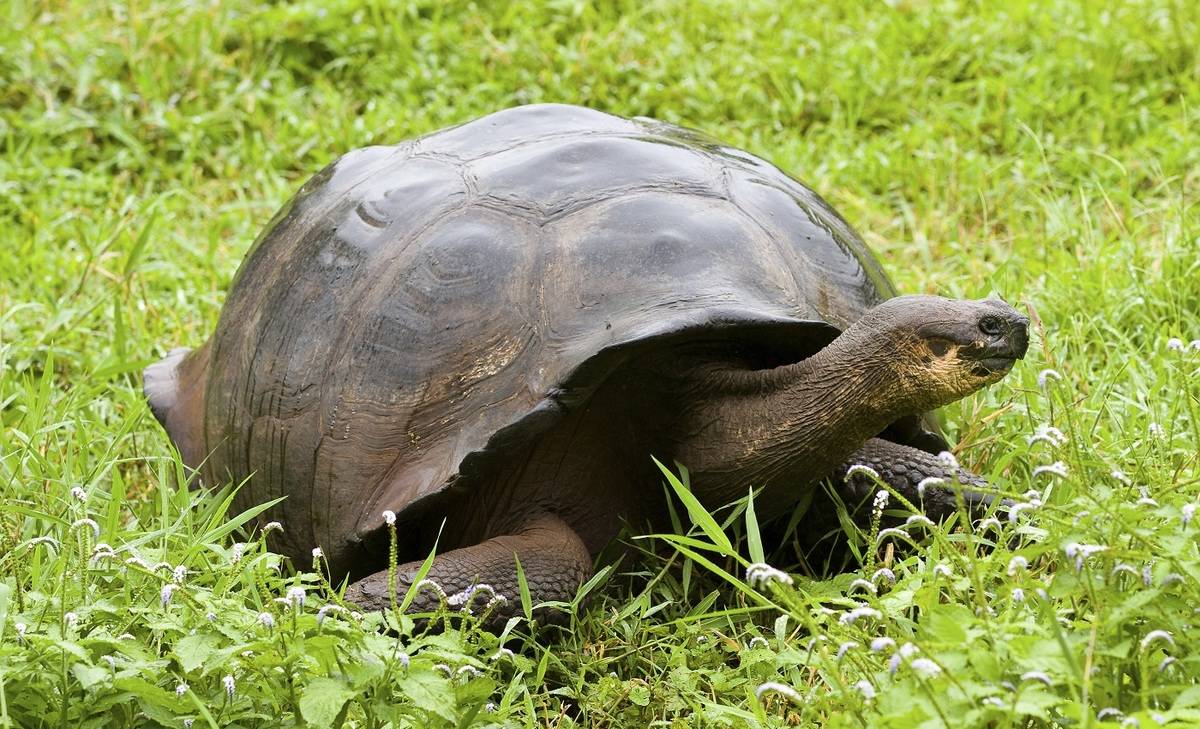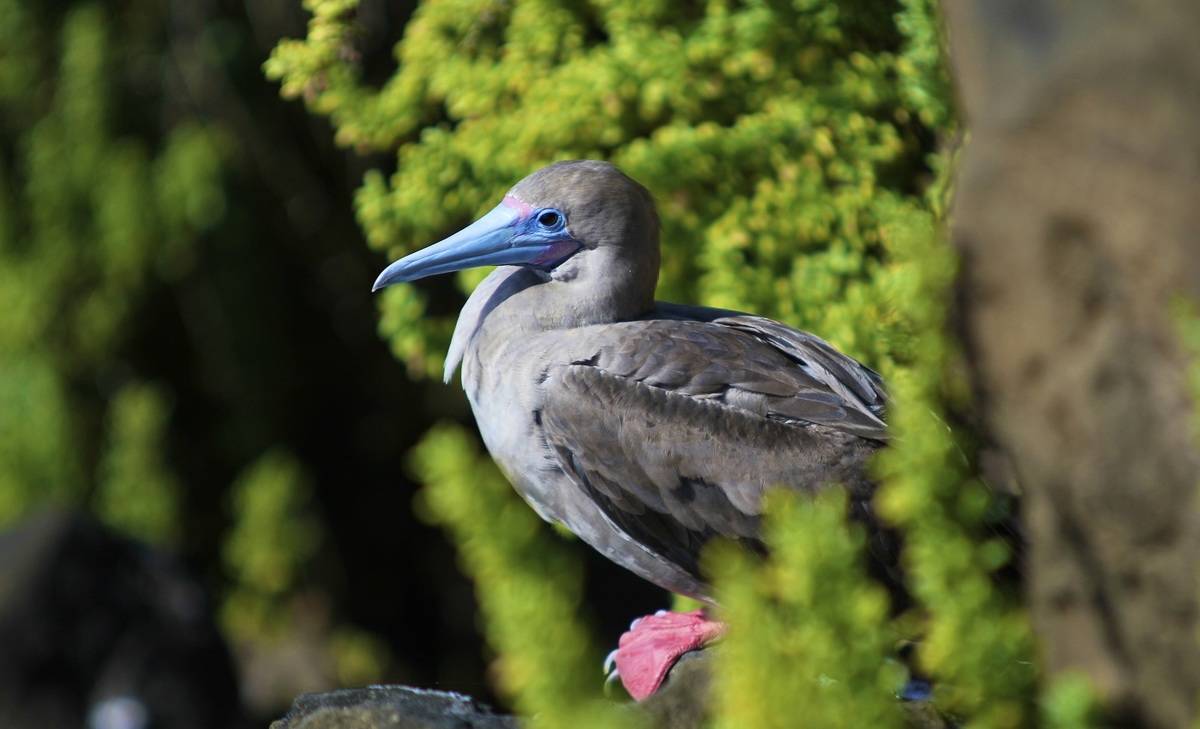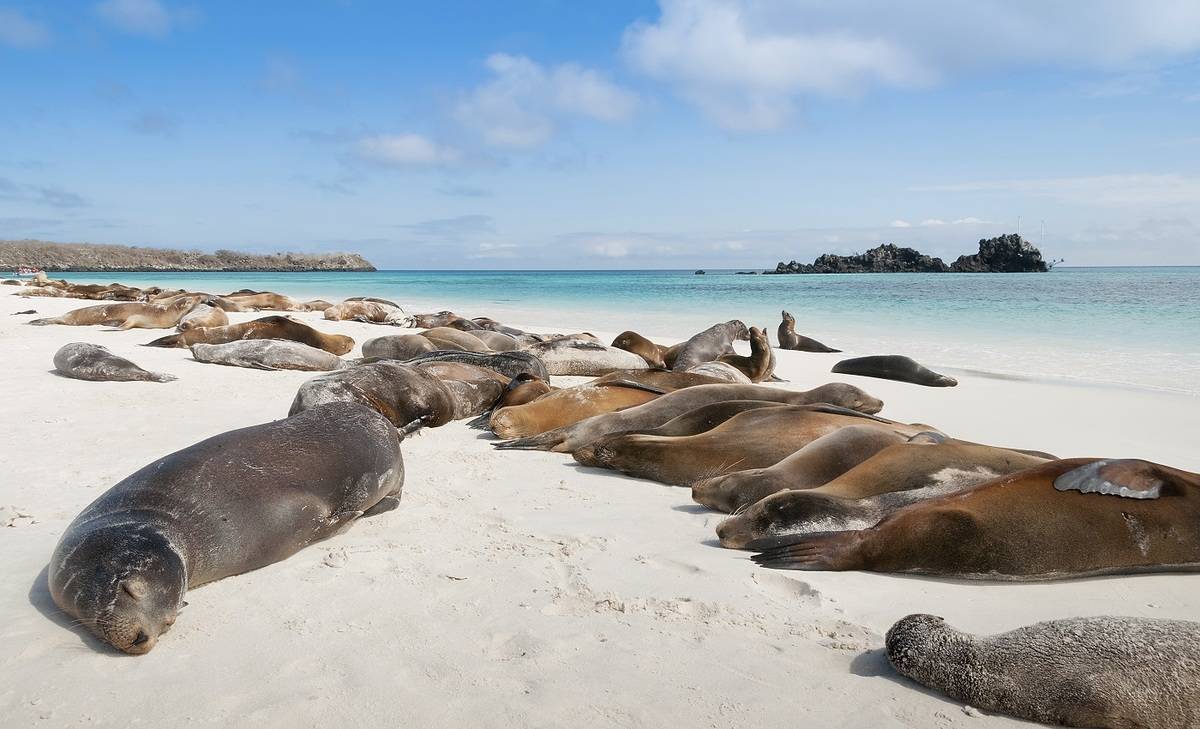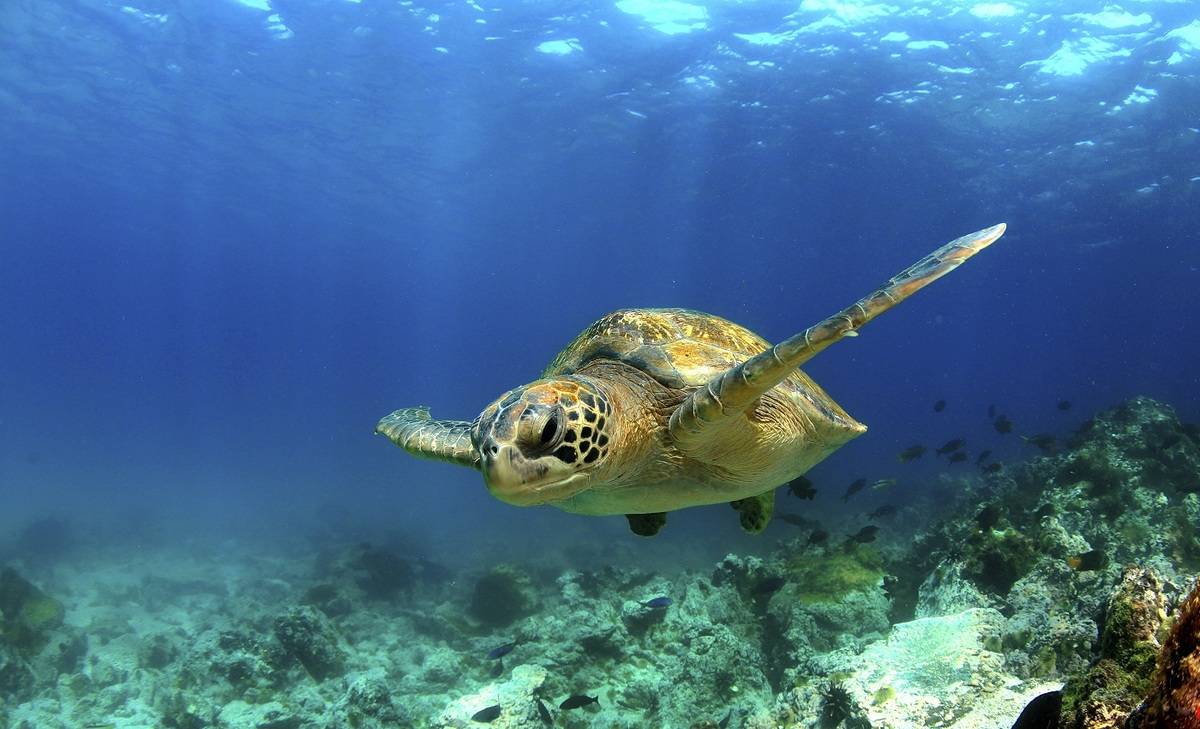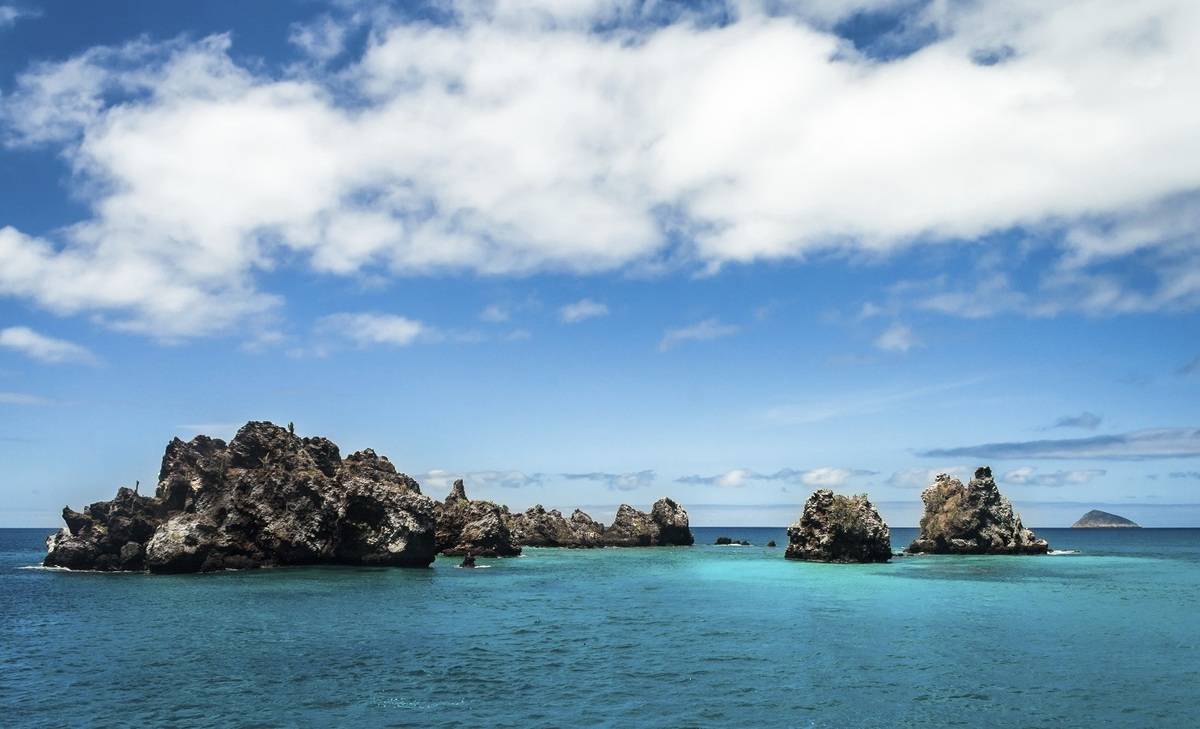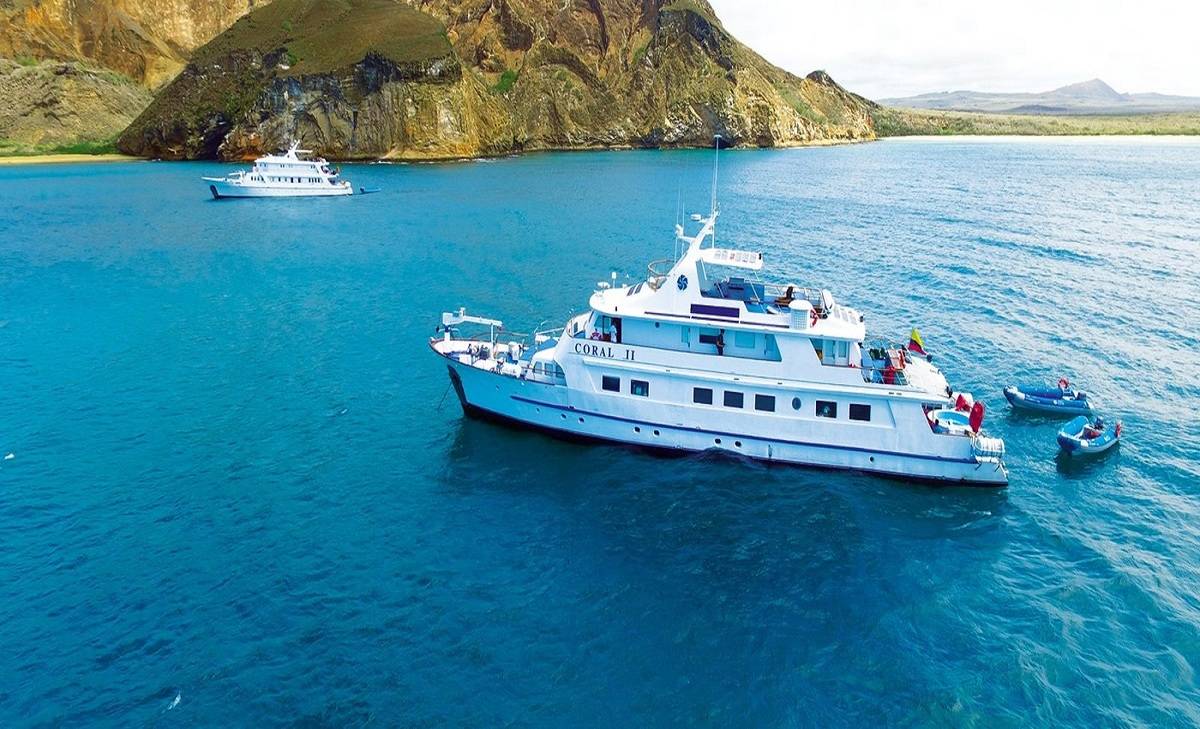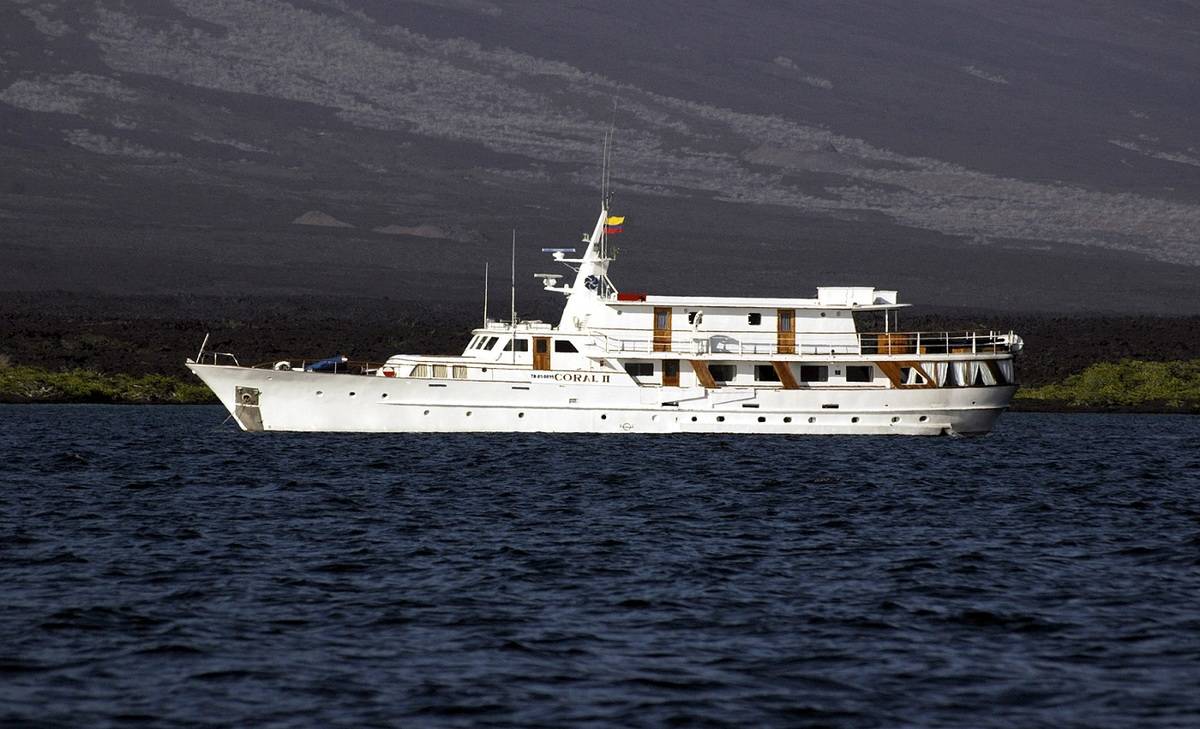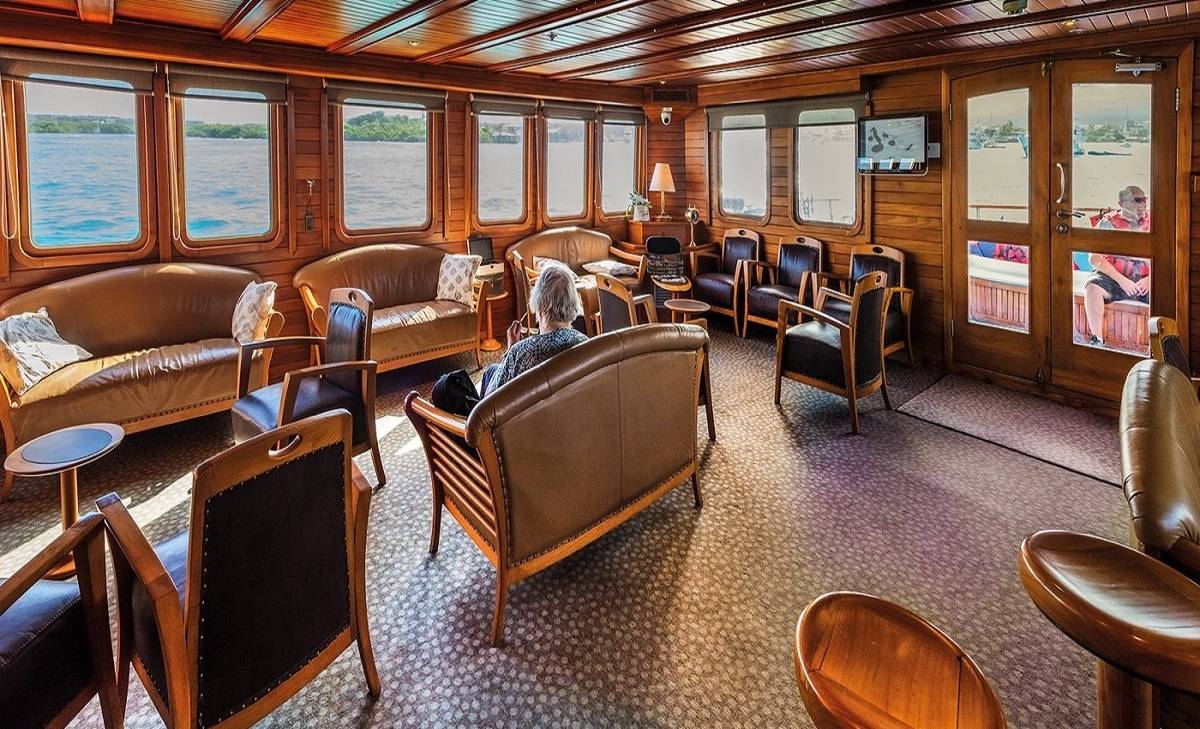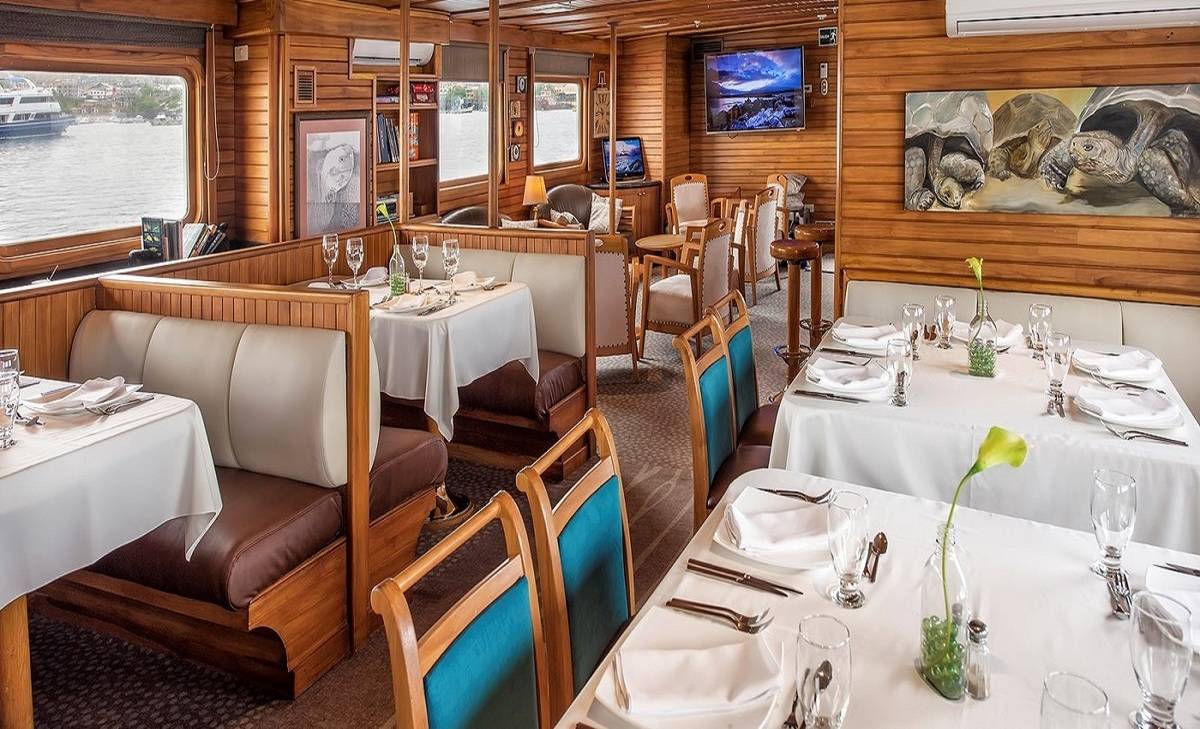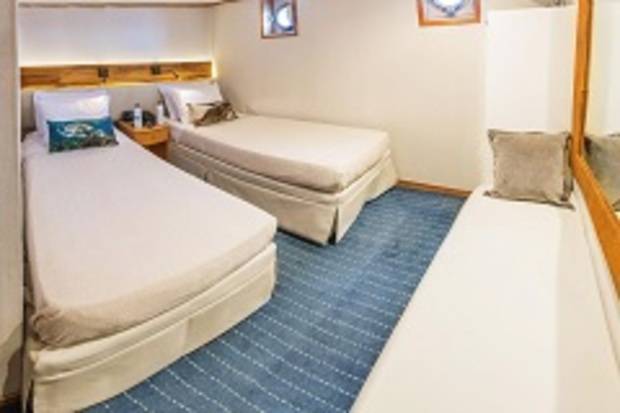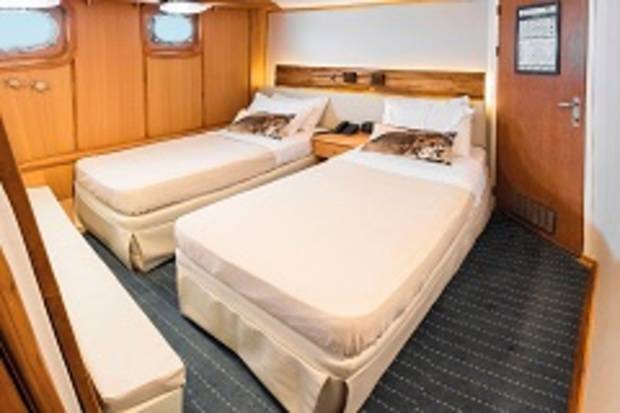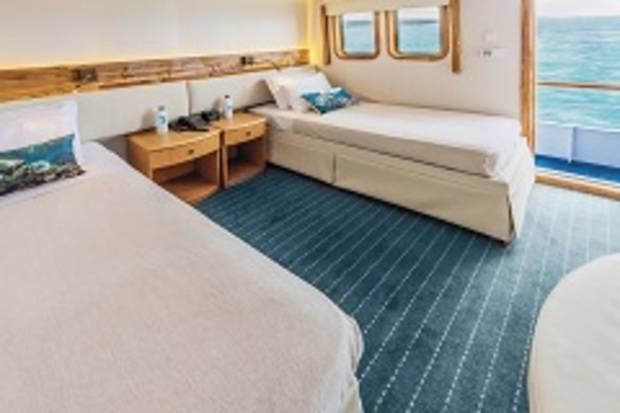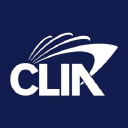South Galapagos Islands
5 Days - Coral I & II
Take a 5 day cruise of the beautiful Galapagos Islands in one of the most luxurious yachts available. Spend 5 days cruising through the South-Eastern Islands. Explore some of the world's most unique flora and fauna with up-close and personal interactions. You won't miss any of the sights whilst on board thanks to the ample panoramic windows which the Coral I and Coral II offer.

Home » Coral I & II: South Galapagos Islands
Itinerary Highlights
- Explore the volcanic eruption of the five volcanoes which formed the largest island of the Galapagos Islands.
- Learn about the Galapagos giant tortoise breeding program.
- Explore volcanic formations and the famous Soplador blowhole.
- Hike through mangroves and see one of the largest flamingo populations in the Galapagos.
- Swim and snorkel amongst sea turtles, reef fish and seal lions.
Itinerary in Brief
- Day 1: Santa Cruz Island - Interpretation Center & Tijeretas
- Day 2: Cerro Brujo - Pitt Point & Pitt Islet
- Day 3: Suarez Point - Gardner Bay, Osborn or Gardner Islets
- Day 4: Cormorant Point/Devil's Crown/Champion - Post Office
- Day 5: Highlands Tortoise Reserve - Baltra Island
* Looking for a longer cruise? Galapagos South & Eastern Islands Coral I & II also offer special Itineraries for 8,11,12 & 15 day cruises, please call us for details
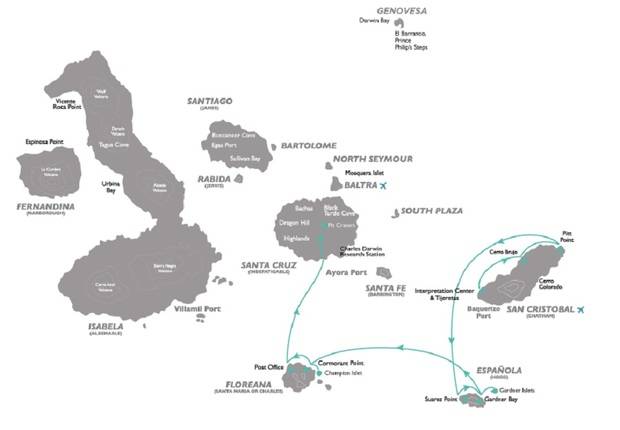
Day 1: Santa Cruz Island - Interpretation Center & Tijeretas
Departure from Quito or Guayaquil to Baltra (2 ½ hours flight). Passengers are picked up at the airport by our naturalist guides and taken on a ten minute bus drive to the pier to board the M/Y Corals.
Dry landing in Puerto Baquerizo Moreno, capital of the Galapagos Islands. Passengers visit the Interpretation Centre, an excellent place to learn about Natural History in the Galapagos. The Museum of Natural History displays information on the volcanic origins of the islands, their remoteness from the continent, ocean currents, climate, the arrival of the different species and their colonization, among other points of interest. The human history is also showcased, chronologically narrating the most significant events related to the discovery and colonization of the islands. Tijeretas Hill which involves a high intensity walk through beautiful landscapes ending with a magnificent view nearby a large frigate bird colony.
Day 2: Cerro Brujo - Pitt Point & Pitt Islet
Wet landing. Cerro Brujo is an eroding tuff cone that at several locations is composed of "aa" lava formations, and a beautiful white sand beach, great for snorkelling and sunbathing. We visit a lagoon where migratory bird species can be seen: Black-necked Stilts, Ruddy Turnstones, Whimbrels, other sandpiper species and White-cheeked Pintails. Cerro Brujo offers beautiful views of Kicker Rock, the southern part of San Cristobal and the adjacent coast.
Wet landing in Pitt Point followed by a high intensity hike on rocky terrain. The trail includes an olivine beach of 90 meters long and a path that climbs to the top of a volcanic tuff, through several magnificent viewpoints. This is probably the only site where the three booby species of the Galapagos can be seen together: Nazca, Blue-footed, and Red-footed; as well as two species of frigate birds and a sea lion colony; it is also excellent for dinghy rides and snorkelling, where a good range of sea birds can be observed.
Day 3: Suarez Point - Gardner Bay, Osborn or Gardner Islets
Dry landing in Suarez Point. An island of geological interest, we explore volcanic formations and a riveting wildlife: large sea lion colonies and seabirds including Española mockingbird, Nazca boobies and the spectacular red billed tropic bird. You will also encounter marine iguanas, lava lizards, and the colourful Sally Lightfoot crabs. A somewhat lengthy hike will bring you among Nazca and Blue-footed Boobies, right up to nesting grounds that sometimes overlap the trail. Other birding favourites include Galapagos Dove, Galapagos Hawk, Swallow-tailed Gulls and the world’s largest colony of Waved Albatross, an unequivocal highlight during mating season (May-December). Admire the island’s dramatic backdrop, featuring the famous Soplador, a seaward blowhole that shoots water at some 23 m. (75 ft.) in the air.
Wet landing on a beautiful white coral sand beach guarded by a colony of sea lions. There are no trails, so we stay along the shore where we can spot Galapagos Hawk, American Oystercatcher, Galapagos Dove, Hood Mockingbird, Yellow Warbler, lava lizards, marine iguanas, and three species of Darwin’s finches: a subspecies (Geospiza fuliginosa) of the Large Cactus Finch, which is similar to the large ground finch, the Small Ground Finch (Geospiza fuliginosa) and the Warbler Finch (Certhidea Olivacea) which is another endemic subspecies. Swimming and snorkelling offers a great variety of Galapagos marine animals: King Angelfish, Creole Fish, Damsel Fish, parrot fish, manta rays, and White-tipped Reef Sharks.
Day 4: Cormorant Point/Devil's Crown/Champion - Post Office
Wet landing on an olivine green sand beach. We hike from the black mangrove beds to a brackish lagoon, which usually holds one of the largest flamingo populations in the Galapagos. This island features some endemic plants such as Scalesia villosa, white and black mangrove, and holy stick.
The trail continues to a beautiful white-sand beach, one of the most important nesting sites of Green Pacific Sea Turtles. It is important to avoid walking in the water due to the Sting Rays that may be hiding in the sand, which can be dangerous if accidentally stepped on. From the beach one can spot sea turtles, Blue-footed Boobies plunging into the water, and small reef sharks floating along the shoreline in search of food. This coral-sand beach marks the end of our trail, and we head back to the olivine beach we landed on to swim or snorkel amongst sea turtles, reef fish, sea lions and, on a good day, white-tipped reef sharks. A small colony of penguins resides on Floreana and can sometimes be observed as well.
Wet landing. Located on the north side of Floreana, the bay is so-named because in 1793 Captain James Colnett installed a wooden barrel which served as an informal post office for sailors passing through, who would take letters with them to their destinations. Today, our visitors continue the tradition by placing unstamped postcards inside the barrel that should reach their destinations for free. It can take weeks, months, even years, not arrive at all, or even arrive before you! We may also encounter Darwin’s finches, Yellow Warbler and lava lizards. Great snorkelling opportunities with Green Pacific Sea Turtles as well, this island is best known for its endemic vegetation: Scalesia villosa, Lecocarpus pinnatifidus, and Galapagos milkwort. Snorkellers can practice on the main beach among playful sea lions.
Day 5: Highlands Tortoise Reserve - Baltra Island Airport
Dry landing. In the mountains of Galapagos is possible to admire different kind of birds, such as: tree and ground finches, vermillion flycatchers, paint-billed crakes, yellow warblers, and cattle egrets (usually standing on the tortoises’ shell). The journey to the reserve offers great opportunities to see the contrasts that the island offers in reference to the variety of ecosystems. The road goes from the coast through the agricultural zone and straight up to the dense humid forests. Often, Galapagos Giant Tortoises are also seen on the way, wandering through pastures in the paddocks. This spot is a birdwatchers’ haven, since almost every land bird present on the island lives or migrates here.
After the visit, passengers will be transferred to the airport for their return flight to Guayaquil or Quito.
Cabin Details
Standard Cabin
7sqm/75sqft, located on the Sea deck, 2 single beds or 1 double bed, private bathroom, air-conditioning, portholes, safe, entertainment system with LCD TV's, hairdryer, 110-220V/60Hz, reading lights and sitting area.
Standard Plus Cabin
12sqm/129sqft, located on the Sea deck, 2 single beds or 1 double bed, private bathroom, air-conditioning, portholes, safe, entertainment system with LCD TV's, hairdryer, 110-220V/60Hz, reading lights and sitting area, some rooms can accomodate extra single bed on request.
Junior Cabin
12sqm, 129sqft, 2 single beds or 1 double bed, located on the Earth and Sky decks, twin beds, extra bed (available in 2 cabins on the Coral I and 1 cabin in the Coral II), private bathroom, air-conditioning, picture windows, safe, entertainment system with LCD TV's, hairdryer, 110-220V/60Hz, reading lights and sitting area.
(Interconnecting doors suitable for families/friends travelling together)
Coral I & II Deckplan
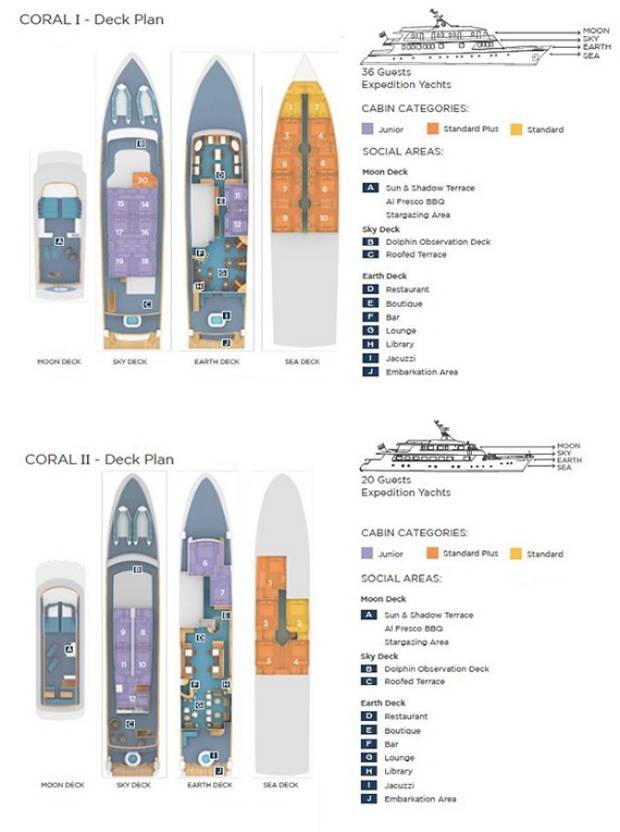
Specifications
Ship Specifications: Coral I
- Length: 131 ft (40 m)
- Wide: 28 ft (8.5 m)
- Decks: 4
- Made in: Germany
- Rebuilt: 2004
- Refurbished in: August 2016
- Guest Capacity: 36
- Crew: 11
- Speed: 12 knots
- Cruise speed: 10 knots
- Guides: 3 multilingual naturalists
- Life Rafts: 4 for 25 pax each
- Dinghies: 2 for 20 pax each
- Kayaks: 2 double, 1 single
- Safety: ISM, SMC, ISSC, IOPP, DOC
- Electricity: 110v & 220V
Ship Specifications: Coral II
- Length: 113 ft (34.4 m)
- Wide: 20.80 ft (6.3) m)
- Decks: 4
- Made in: Holland
- Rebuilt: 2006
- Refurbished in: September 2017
- Guest Capacity: 20
- Crew: 9
- Speed: 12 knots
- Cruise speed: 10 knots
- Guides: 2 multilingual naturalists
- Life Rafts:
- 2 for 25 pax each
- 2 for 8 pax each
- Dinghies: 2 for 17 pax each
- Kayaks: 2 double, 1 single
- Safety: ISM, SMC, ISSC, IOPP, DOC
- Electricity: 110v & 220V
Whats included?
- On-board accommodation
- All meals during your cruise
- Activities/shore excursions as specified
- Bilingual naturalist guides
- Transfers
What’s not included?
- International and internal airfares
- Arrival/departure taxes or reciprocity fees, visa fees where applicable
- Travel insurance
- Fuel surcharges
- Galapagos national park fee US$100
- Transit control card US$20
- Kayaks and wetsuit equipment
- Gratuities
- Any items not mentioned as included

